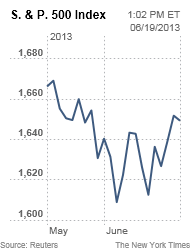The jobless rate in the 17 countries that belong to the euro zone was 12.1 percent in May, adjusting for seasonal effects, according to a report from Eurostat, the European Union statistics agency. That figure compared with 12 percent in April, which was revised down from 12.2 percent reported earlier. Based on the revised figures, May unemployment was at a record high.
Eurostat estimated that 19.2 million people in the euro area were jobless in May, an increase of 67,000 from April. For all 27 countries in the European Union, the unemployment rate was unchanged at 10.9 percent. The European bloc expanded to 28 countries on Monday when Croatia officially joined.
Joblessness in the euro zone has been rising almost without interruption since early 2008, when the financial crisis began, declining only briefly at the beginning of 2011. And analysts see little prospect for a sustained decline anytime soon.
While economists expect the euro zone economy to stabilize in the course of this year, growth will most likely remain too slow to generate large numbers of jobs.
“The measure that offers the greatest potential for job creation in the short to medium term is an easing of credit conditions,” Marie Diron, an economist who advises the consulting firm Ernst Young, said in a statement. “This would allow companies to invest and as a result recruit in the euro zone.”
The European Central Bank will hold its monetary policy meeting on Thursday, but it is not expected to introduce more stimulus to the euro zone economy. A cut in the benchmark rate, to 0.25 percent from a record 0.5 percent, is possible, but many say it would be unlikely to do much to encourage lending in troubled countries like Spain and Italy.
Banks in those countries are trying to cope with rising numbers of bad loans and are reluctant to lend no matter how cheaply they can borrow from the European Central Bank. And the central bank remains reluctant to effectively print more money, as the Federal Reserve in the United States and Bank of England have done, because of opposition from Germany to more aggressive action.
Eurostat also reported on Monday that inflation in the euro zone rose to 1.6 percent from 1.4 percent because of a surge in energy prices. While inflation remains below the central bank’s target of about 2 percent, the uptick is likely to provide a further argument against increasing the benchmark interest rate.
Compounding the bank’s challenge, the numbers released showed that there remained a big difference in economic performance among euro zone countries. These differences make it difficult for the central bank to form a monetary policy that is appropriate for all members.
Unemployment rates in Spain and Greece were about 27 percent in May, with youth unemployment remaining well above 50 percent. In contrast, unemployment in Austria was 4.7 percent and in Germany was 5.3 percent. Both had youth jobless rates below 9 percent.
If there was any good news, economists said, it was that unemployment may not go up much more. “An end to the euro zone labor market downturn is not yet imminent,” Martin van Vliet, an economist at ING Bank, said in a note to investors. “However, with the recession across the euro zone petering out, the peak in unemployment should not be too far away, either.”

Article source: http://www.nytimes.com/2013/07/02/business/global/euro-zone-joblessness-rises.html?partner=rss&emc=rss





